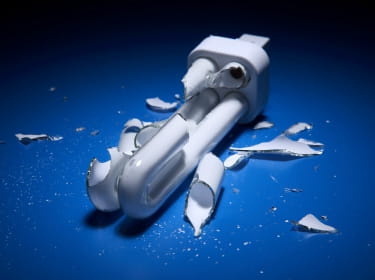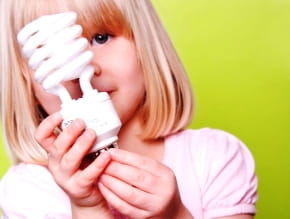Safe Cleanup Tips for Broken CFLs

The Bottom Line
Compact fluorescent light bulbs (CFLs) contain small amounts of mercury. A small percentage of this mercury can be released into the air if the bulbs are broken. Careful clean-up of broken bulbs can minimize the risk of mercury exposure. Mercury also can be released into the environment if bulbs are not recycled properly.

The Full Story
Compact fluorescent light bulbs (CFLs) contain small amounts of mercury. A small percentage of this mercury can be released into the air if the bulbs are broken. Mercury also can be released into the environment if bulbs are not recycled properly.
The amount of mercury in a CFL may be up to about 5 milligrams (mg). (By contrast, a mercury-containing fever thermometer contained about 500 mg.) Mercury can cause poisoning in some circumstances. Even so, people are encouraged to replace their "old fashioned" incandescent bulbs with CFLs. This is because much less environmental mercury is generated by the manufacture of CFLs than by the manufacture of incandescent bulbs.
To minimize chances of any individual health problems, care should be taken when handling these bulbs to avoid breakage. Special steps are needed if a bulb breaks indoors.
- A small amount of mercury vapor is released immediately. Open any windows, leave the room without stepping into the shattered bulb, and close the door. Stay out of the room for at least 15 minutes. Turn off the heat or air conditioning so that any mercury vapor is not circulated.
- Do not use a vacuum or broom to clean up the pieces. Scoop up what you can with a stiff piece of paper or cardboard. Try to get the rest with sticky tape and/or damp paper towels. Put all debris in a sealed glass jar or sealed plastic bag. Put the jar or bag outside. Wash your hands.
- It's OK to vacuum after all material is cleaned up, but dispose of the vacuum cleaner bag afterwards in a sealed plastic bag.
- If fabric comes in contact with the broken glass and mercury powder, it should be thrown away. Laundering could spread the mercury.
- Check with your community about disposing of the material. Some places suggest it be put in the trash and others require it to be taken to a hazardous waste disposal site.
The risks to human health from individual broken CFLs is minimal; some scientists would argue that there are no real risks. Care in disposing of broken bulbs and disposing of used bulbs is important to avoid environmental contamination. Manufacturers continue to reduce the amount of mercury contained in CFLs. Communities continue to revise their requirements for disposal of broken and burned-out bulbs as recycling technology evolves. It is clear that these bulbs are here to stay and soon will be found in virtually every residence and business in the U.S.
For questions about mercury or the health effects of broken light bulbs, call 1-800-222-1222. Poison specialists will answer your call 24 hours a day.
Rose Ann Gould Soloway, RN, BSN, MSEd, DABAT emerita
Clinical Toxicologist
Prevention Tips
- Handle light bulbs carefully to prevent breakage.
- If a fluorescent light bulb breaks, follow clean-up instructions thoroughly to avoid mercury exposure.
- Recycle bulbs properly to avoid releasing mercury into the environment.
This Really Happened
A 23-month old boy was seen by a doctor because he lost weight, had little appetite, was irritable, sweated an unusual amount, had a rash, and his fingers and toes were red and peeling. He wouldn't walk, didn't sleep well, whined, and kept wringing his hands. He also had high blood pressure. Mercury poisoning was diagnosed and treated, but his parents couldn't identify the source of mercury; other family members were not ill. An investigation traced the mercury to broken fluorescent light bulbs which had been stored in an area where the child played. He was discharged from the hospital to his grandmother's home, where he recovered rapidly.
Reference: Tunnessen WW Jr., McMahon JKJ, Baser M. Acrodynia: exposure to mercury from fluorescent light bulbs. Pediatrics. 1987;79:786-789.
For More Information
Instructions for cleaning up broken bulbs (EPA)References
United States Environmental Protection Agency. Cleanup and Disposal Guidelines for Compact Fluorescent Light Bulbs (CFLSs) June 2008. Accessed Jul 16 2014.
Johnson NC, Manchester S, Sarin L, Gao Y, Kulaots I, Hurt RH. Mercury vapor release from broken compact fluorescent lamps and in situ capture by new nanomaterial sorbents. Env Sci Techol. 2008;42:5772-5778.
Kondro W. Mercury disposal sole health concern with fluorescent lights. CMAJ. 2007;177:136-137.
Salthammer T, Uhde E, Omelan A, Lüdecke A, Moriske H-J. Estimating human indoor exposure to elemental mercury from broken compact fluorescent lamps (CFLs). Indoor Air. 2012; 22: 289–298.
Stemp-Morlock G. Mercury: Cleanup for broken CFLs. Environ Health Perspect. 116(9):A378.
Prevention Tips
- Handle light bulbs carefully to prevent breakage.
- If a fluorescent light bulb breaks, follow clean-up instructions thoroughly to avoid mercury exposure.
- Recycle bulbs properly to avoid releasing mercury into the environment.
This Really Happened
A 23-month old boy was seen by a doctor because he lost weight, had little appetite, was irritable, sweated an unusual amount, had a rash, and his fingers and toes were red and peeling. He wouldn't walk, didn't sleep well, whined, and kept wringing his hands. He also had high blood pressure. Mercury poisoning was diagnosed and treated, but his parents couldn't identify the source of mercury; other family members were not ill. An investigation traced the mercury to broken fluorescent light bulbs which had been stored in an area where the child played. He was discharged from the hospital to his grandmother's home, where he recovered rapidly.
Reference: Tunnessen WW Jr., McMahon JKJ, Baser M. Acrodynia: exposure to mercury from fluorescent light bulbs. Pediatrics. 1987;79:786-789.
